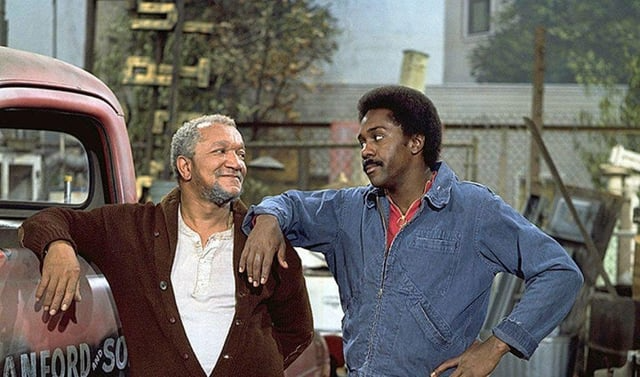
In the history of television, few shows have had a more profound and lasting impact than Sanford and Son. Premiering in 1972, this groundbreaking sitcom was a cultural phenomenon that not only broke new ground for television but also laid the creative foundation for an entire generation of sitcoms that would follow. From its iconic characters and biting humor to its willingness to tackle social issues with wit and honesty, the show’s influence can be seen in the DNA of classic comedies like The Jeffersons and Martin, proving that its legacy is far from just a fond memory. It is a blueprint for modern sitcoms.
The show’s genius was not just in its ability to make people laugh; it was in its audacious and often-rebellious spirit. It proved that a show centered on a Black family could be a ratings powerhouse and a cultural touchstone. It challenged conventions, shattered stereotypes, and gave a voice to a part of America that had been largely ignored by mainstream television. The show’s influence is a testament to its courage, its creativity, and the undeniable genius of its star, the legendary Redd Foxx.
The Rise of the Lovable Curmudgeon
At the heart of Sanford and Son’s success was Fred Sanford, a grumpy, scheming, and endlessly quotable junkman who used his wit and his fake heart attacks to get his way. Before Fred Sanford, the “grumpy old man” archetype in sitcoms was a novelty. But with Fred, it became a comedic art form. He was a man who was always at odds with the world, but his deep, underlying love for his family, particularly his son, Lamont, was what made him so endearing.
This character archetype served as a clear inspiration for George Jefferson in The Jeffersons. Both characters are opinionated, stubborn, and often at war with their neighbors and family. But underneath their tough exteriors is a fierce sense of loyalty and a love for their families that grounds the show in emotion. George Jefferson’s rags-to-riches story and his constant clashes with his son, Lionel, and his white neighbor, Tom Willis, were a direct evolution of the kind of character-driven humor that Fred Sanford pioneered. Both characters proved that you could be a hilariously unlikable character while still being the emotional center of the show.
Breaking the Racial Barrier in Sitcoms
Perhaps the most significant and lasting influence of Sanford and Son was its role as a pioneer for Black television. In the early 1970s, there were few shows that accurately and honestly portrayed the lives of Black families. Sanford and Son changed that. It was one of the first shows to center its narrative on the everyday lives, relationships, and struggles of a Black family. It showed their joy, their frustrations, and their dreams, all while making audiences laugh.
This opened the door for a wave of successful Black sitcoms that would follow, from Good Times and The Jeffersons to later classics like Martin and The Fresh Prince of Bel-Air. These shows, like Sanford and Son, proved that Black stories were not just a niche market; they were a central part of the American experience. Martin, in particular, owes a significant debt to the show. It was a show that was built on the back of a single comedic genius—Martin Lawrence—just as Sanford and Son was built on the back of Redd Foxx. The show’s focus on Martin’s relationships with his family and friends, and its ability to find humor in everyday situations, was a clear echo of the comedy that Fred and Lamont perfected decades earlier.
The Power of the Catchphrase
Sanford and Son had a knack for creating memorable, repeatable catchphrases that became a part of the cultural lexicon. Fred’s “You big dummy!” and “It’s the big one, Elizabeth!” were more than just lines; they were a shorthand for the show’s comedic genius. This use of iconic catchphrases, delivered with perfect comedic timing, was a powerful tool that influenced a generation of sitcoms.
The Jeffersons had its own memorable catchphrase in the opening theme song, “Movin’ On Up,” which perfectly captured the show’s theme of upward mobility. Martin‘s famous line, “Damn, Gina!” became a pop culture phenomenon that is still widely quoted today. These shows understood the power of a repeatable phrase to not only generate laughs but to also build a deeper connection with the audience. They knew that a well-crafted catchphrase could become a part of a show’s identity, just as it did for Sanford and Son.
The Blueprint for Character-Driven Comedy
Ultimately, Sanford and Son’s lasting legacy lies in its dedication to character-driven comedy. The show was not reliant on elaborate plots or absurd situations. Its humor came from the simple, yet profound, relationship between a father and a son. The clashes between Fred’s old-school ways and Lamont’s modern sensibilities were the engine of the show.
This focus on character and relationships over plot was a blueprint for countless sitcoms that followed. Martin, for example, was a show that was built on the back of the hilarious chemistry between its main characters. The jokes came from their personalities, their quirks, and their relationships. This kind of comedy, rooted in human truth, is what makes a show timeless.
Sanford and Son was not just a sitcom; it was a television institution that changed the game forever. It proved that a show with a Black cast could be a cultural force, that a single comedic genius could carry a show, and that a family’s love, no matter how tough, could be the ultimate source of a show’s heart and humor. The influence of Sanford and Son can be seen in every modern sitcom that values character, relationships, and a good, old-fashioned laugh.
